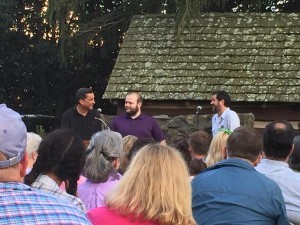“Then will the eyes of the blind be opened and the ears of the deaf unstopped.
Then will the lame leap like a deer, and the mute tongue shout for joy.
Water will gush forth in the wilderness and streams in the desert.”
– Isaiah 35:4-6
It’s Messiah Week!
#1: Neo from The Matrix
#2: Paul Atreides from Dune
If you’re Christian, you believe the Messiah has already arrived on Earth; if you’re Jewish, you believe he is still yet to come. That hasn’t stopped creator after creator from adopting (or co-opting) messianic imagery to tell their own stories.
Messiah stories are easy to explain and fairly easy to write if you’re not worried about the implications, so fans end up seeing a lot of it, for better or worse. Done correctly, messiah stories reach us right at the heart with stories about sacrifice, belief and devotion. Done cheaply, the two-dimensional Space Jesus splays his arms in a cruciform fashion, grows a beard, and waves his hands to create cheap miracles. It’s a story we’ve heard over and over, so it’s a story that loses its oomph, sometimes. The central sacrifice, the death and resurrection, the temptation from the evil figure — it can get a little overdone until a writer cuts their reliance on overdone imagery and instead cuts to the heart of the story. The problem with many messiah stories is that the central Messiah in Western Civilization — Jesus Christ — was not a secular savior. He didn’t come to rescue the Jews from Roman rule, even though people around him certainly encouraged him to use his power to do so. Many modern messiah stories, though, are more about bodies and politics than faith or souls.
For the next couple days, we’ll talk about the best (and worst!) Messiah-figures in science fiction and fantasy, and their varying levels of effectiveness:
 Let’s talk about Neo.
Let’s talk about Neo.
Messiah Level: SUPER OBVIOUS.
There is no ambiguity to what the Wachowskis were doing with their central character in the Matrix trilogy. Neo is such a literal Jesus analogue that some bloggers and authors wonder if The Matrix and it sequels could be counted as “Christian” films, even if the Wachowskis many not have intended them to be such.
 Not exactly loaves and fishes there, Neo.
Not exactly loaves and fishes there, Neo.
The central figure of The Matrix and its lesser sequels is pretty much a Jesus surrogate from the beginning; he is “The One,” performing miracles on behalf of the residents of “Zion” and the humans still enslaved by the Machines in the Matrix. He lives among them, in their poverty, wearing the same clothes, eating the same food, and encouraging them with his words and presence. In this way, he is eminently messiahlike.
Neo’s first messianic moment comes at the end of The Matrix. After having been gravely wounded — and possibly killed — by Agent Smith in the Matrix, Trinity sits over Neo’s dying body in the Nebuchadnezzar and instructs Neo to get up, telling him that she is in love with him, believing wholly in his identity as “The One.” Neo is restored to life with energy from Trinity’s miraculous love, with a never-before-seen set of abilities to bend the reality of the Matrix like the Machines do, to dodge bullets and to slow down time. There’s a small side-effect to this; fully actualizing as “The One” also frees Agent Smith from the control of the machines, causing chaos down the line for both sides of the story.
Christian scholars translate “Trinity” literally here, seeing her as a God analogue, a figure of pure love and forgiveness breathing life into Jesus at the end of the third day.
 Just a little obvious there, Andy and Lana.
Just a little obvious there, Andy and Lana.
Neo makes his final messianic sacrifice at the end of The Matrix: Revelations, when he gives himself over to the Machines and is carried off, his arms cruciform. While it’s heavily implied at the end the Neo is truly dead, it is also implied that his death is the only thing that could have saved the humans by eliminating the viral, evil Agent Smith from the world. When Neo is carried off by the Machines, his arms are cruciform, and his body disappears into a light that is very reminiscent of a golden cross or the Buddhist lotus. Is Neo truly dead? Do we care?
That is answered at the end of the movie, when the Oracle utters, “It is done.”
If you’re a Christian scholar, you’ll hear this as a clear callback to Jesus on the cross, saying “It is finished.”
Of course, that wasn’t quite the end of the story, either, was it?
– – –
Subscribe to Sacred Earthlings for new story notifications!
Read the August Third Order story, “A Tomb For Demrick Fauston,” by Fred McGavran!
Support Sacred Earthlings through this Amazon link:


















